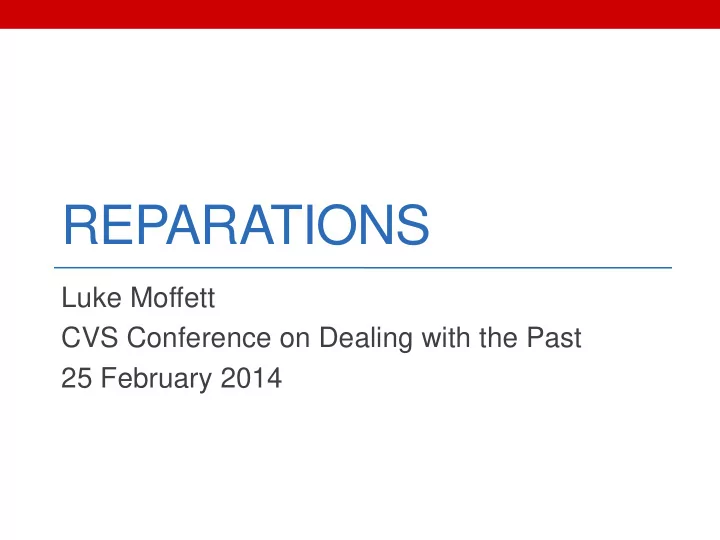

REPARATIONS Luke Moffett CVS Conference on Dealing with the Past 25 February 2014
Overview • What are reparations? • What is the purpose of reparations? • Types of reparations • Who is eligible? • Who is a victim for the purpose of reparations? • Who is responsible for reparations?
What are reparations? • Victim-centred measures aimed at repairing harm caused • Reparations are meant to respond to the needs of victims and to prevent violence recurring • In comparison to other processes: • Prosecutions focus on the acts of perpetrators • Truth commissions try to uncover the truth for the whole of society • Reparations work best when used with truth commissions and judicial processes
What is the purpose of reparations? • Adequate, effective and prompt reparation is intended to promote justice by redressing gross violations of international human rights law or serious violations of international humanitarian law. Reparation should be proportional to the gravity of the violations and the harm suffered. • Principle 15, UN Basic Principles and Guidelines on the Right to a Remedy and Reparation for Victims of Gross Violations of International Human Rights Law and Serious Violations of International Humanitarian Law (2005) • Note: This is ‘soft law’, i.e. it is not legally binding • ‘Judicial Remedy’ for violations of European Convention Human Rights • Section 8, Human Rights Act 1998 – binding law
Purpose of Reparations • Remedy the harm suffered by victims • Broader understanding of justice as ‘repairing harm’ • Reconciliation and social solidarity • Redress imbalance of conflict • Restore victims’ dignity, reputation, and improve their quality of life
Types of reparations The Eye that • Compensation Cries memorial, • Lump sums Peru • Annual/monthly pensions • Restitution • Return of property/restore rights • Rehabilitation • Physical, mental and social care • Satisfaction • Apologies, memorials, investigations • Recovery of disappeared • Guarantees of non-repetition • Reform of abusive institutions to prevent future suffering
Who is eligible? • Victims, their family members and dependents • Individuals who intervened/witnessed, or assisted victims (carers) • Victims entitled to reparations even if the perpetrator is not identifiable or prosecuted • All victims? • A number of countries focus on those most vulnerable and who continue to suffer • Such as those individuals who were killed, disappeared, tortured or injured • Reparations are not meant to enrich or impoverish victims
Who is a victim for the purposes of reparation? 1. International law: • All those who suffer as a result of a violence act • Victim focused – to remedy suffering, no matter the action of the victim or identification of the perpetrator (non-discriminatory) 2. State practice: All those who suffer from a crime or human rights violation i. • Limited to identifiable crimes and violations All those who suffer from a crime or human rights violation, excluding ii. those who at the time were a member of an illegal organisation: • Not entitled to/reduced compensation • Problem of identifying membership: • Use of inappropriate interrogations and supergrass evidence • Some individuals never convicted
Who is responsible for reparations? • State responsible for acts or failures to act by its own agents that resulted in death or serious injury • Individual perpetrators can be held responsible • If perpetrator is unknown or penniless, state is responsible for reparations • Penniless perpetrators can contribute to measures of satisfaction such as apologies and acknowledgement of responsibility • State should establish a reparation mechanism for all victims
Summary Reparations have three components: 1. Acknowledgement • Public recognition of victims’ suffering 2. Responsibility • Made by those responsible, such as the state, paramilitary organisations, or individuals • Ultimately the state is responsible for establishing reparation mechanisms 3. Remedy • Provide appropriate remedies to repair harm caused: • Compensation, restitution, rehabilitation, satisfaction, guarantees of non recurrence
More information on reparations UN Basic Principles and Guidelines on the Right to a Remedy and Reparation for Victims of Gross Violations of International Human Rights Law and Serious Violations of International Humanitarian Law (2005) go.qub.ac.uk/remedy
Recommend
More recommend